Australian megafauna
The term Australian megafauna refers to the megafauna in Australia[1] during the Pleistocene Epoch. Most of these species became extinct during the latter half of the Pleistocene, and the roles of human and climatic factors in their extinction are contested.
There are similarities between the prehistoric Australian megafauna and some mythical creatures from the Aboriginal Dreamtime.[2]
Causes of extinction
Many modern researchers, including



New evidence based on accurate
Chemical analysis of fragments of
"Imperceptive overkill"; a scenario where anthropogenic pressures take place; slowly and gradually wiping the megafauna out; has been suggested.[17]
On the other hand, there is also evidence to suggest that (contrary to other conclusions) the megafauna lived alongside humans for several thousand years.[18][19] The question of if (and how) the megafauna died before the arrival of humans is still debated; with some authors maintaining that only a minority of such fauna remained by the time the first humans settled on the mainland.[20] One of the most important advocates of human role, Tim Flannery, author of the book Future Eaters, was also heavily criticised for his conclusions.[21][22] A surprisingly late date of 33-37 kya is known for a Zygomaturus specimen from the Willandra Lakes Region in New South Wales, the latest known date for any Australian Megafauna. This is well after aboriginal arrival in Australia around 50 kya.[23]
A 2021 study found that the rate of extinction of Australia's megafauna is rather unusual, with some more generalistic species having gone extinct earlier while highly specialised ones having become extinct later or even still surviving today. A mosaic cause of extinction with different anthropogenic and environmental pressures was proposed.[24]
Living Australian megafauna
The term "megafauna" is usually applied to large animals (over 100 kg (220 lb)). In Australia, however, megafauna were never as large as those found on other continents, and so a more lenient criterion of over 40 kg (88 lb) is often applied.[25]
Mammals
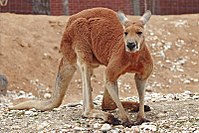
- The red kangaroo (Osphranter rufus) grows up to 1.8 m (6 ft) tall and weighs up to 85 kg (187 lb). Females grow up to 1.1 m (3 ft 7 in) tall and weigh up to 35 kg (77 lb). Tails on both males and females can be up to 1 m (3 ft 3 in) long.[citation needed]
- The eastern grey kangaroos (Macropus giganteus). Although a male typically weighs around 66 kg (145 lb) and stand almost 2 m (6 ft 7 in) tall, the scientific name Macropus giganteus (gigantic large-foot) is misleading, as the red kangaroo living in the semi-arid inland is larger.
- The Kimberley region of Western Australia. They can weigh as much as 47 kg (104 lb) and grow over 1 m (3 ft 3 in) long.
- Eastern Australia and Tasmania, preferring temperate forestsand highland regions.
Birds

- The emu (Dromaius novaehollandiae)
- The southern cassowary (Casuarius casuarius)
Reptiles
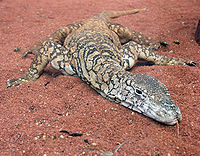
- predatory lizards, are often quite large or bulky, with sharp teeth and claws. The largest extant goanna is the perentie(Varanus giganteus), which can grow over 2 m (6 ft 7 in) in length. However, not all goannas are gargantuan: pygmy goannas may be smaller than a man's arm.
- A healthy adult male saltwater crocodile (Crocodylus porosus) is typically 4.8–7 m (15 ft 9 in – 23 ft 0 in) long and weighs around 1,000 kg (2,200 lb)), with many being much larger than that.[26] The female is much smaller, with typical body lengths of 2.5–3 m (8 ft 2 in – 9 ft 10 in). An 8.5 m (28 ft) saltwater crocodile was reportedly shot on the Norman River of Queensland in 1957; a cast was made of it and is on display as a popular tourist attraction. However, due to the lack of solid evidence (other than the plaster replica), and the length of time since the crocodile was caught, it is not considered "official".[clarification needed]
- The freshwater crocodile (Crocodylus johnstoni) is a relatively small crocodilian. Males can grow to 2.3–3 m (7 ft 7 in – 9 ft 10 in) in length, while females reach a maximum length of 2.1 m (6 ft 11 in). Males commonly weigh around 60 kg (130 lb), with large specimens up to 85 kg (187 lb) or more, as against the average female weight of 20 kg (44 lb). In places such as Lake Argyle and Nitmiluk National Park (Katherine Gorge), there exist a handful of confirmed 4-metre (13 ft) individuals.
Extinct Australian megafauna
The following is an incomplete list of extinct Australian megafauna (monotremes, marsupials, birds and reptiles) in the format:
- Latin name, (common name, period alive), and a brief description.
Monotremes

Monotremes are arranged by size with the largest at the top.
- Murrayglossus hacketti was a sheep-sized echidna uncovered in Mammoth Cave in Western Australia, and is the largest monotreme so far uncovered.
- Riversleigh.
- Megalibgwilia ramsayi was a large, long-beaked echidna with powerful forelimbs for digging.
Marsupials
Marsupials are arranged by size, with the largest at the top.
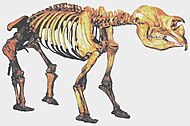
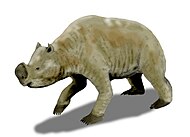
1,000–3,000 kilograms (2,200–6,610 lb)
- Diprotodon optatum is not only the largest known species of diprotodontid, but also the largest known marsupial to ever exist. Approximately 3 m (10 ft) long and 2 m (7 ft) high at the shoulder and weighing up to 2,780 kg (6,130 lb),[27] it resembled a giant wombat. It is the only marsupial known, living or extinct, to have conducted seasonal migrations.[28]
- Palorchestes azael was a diprotodontoid similar in size to Zygomaturus. It had long claws to grasp branches with. It lived during the Pleistocene.[2]
100–1,000 kilograms (220–2,200 lb)
- Euowenia grata
- Euryzygoma dunense
- incisorsto shovel up reeds and sedges for food.
- Macropus pearsoni and M. ferragus
- Mukupirna nambensis, in its own family Mukupirnidae within the Vombatiformes suborder of the large marsupial order Diprotodontia[29]
- Nototherium was a diprotodontoid relative of the larger Diprotodon.
- Phascolonus gigas
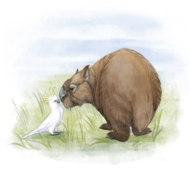
Phascolonus gigas - Procoptodon goliah (the giant short-faced kangaroo) is the largest-known kangaroo to have ever lived. It grew 2–3 metres (7–10 feet) tall, and weighed up to 230 kg (510 lb).
- Procoptodon rapha, P. pusio and P. texasensis
- Protemnodon, a genus of wallaby with four known giant species out of 11 known species[30]
- Palorchestes parvus
- Ramsayia magna
- Sthenurus tindalei and S. atlas
- , It had a catlike skull with large slicing pre-molars, a retractable thumb-claw and massive forelimbs. It was almost certainly carnivorous and a tree-dweller.
10–100 kilograms (22–220 lb)
- Simosthenurus pales
- Phascolarctos stirtoni (the giant koala) was similar in structure to the modern koala (P. cinereus), but one-third larger.
- Phascolomys medius
- Lasiorhinus angustidens
- Thylacinus cynocephalus (the thylacine, Tasmanian wolf or Tasmanian tiger), which notably survived into recent history (the last known individual died in 1936).

A 1936 picture of a thylacine at Beaumaris Zoo, Tasmania. - Congruus congruus, a wallaby from Naracoorte
- Troposodon minor
- Sthenurus oreas
- leaf-eating kangaroos identified in fossils found in Naracoorte Caves National Park.
- Simothenurus brownei
- Propleopus oscillans (the giant rat-kangaroo) was a large (about 70 kg (150 lb) rat-kangaroo with large shearing and stout grinding teeth that indicate it may have been an opportunistic omnivore able to eat invertebrates, vertebrates (possibly carrion), fruits, and soft leaves. Grew to about 1.5–3 m (5–10 ft) in height.
- Simothenurus maddocki
- Sthenurus andersoni
- Vombatus hacketti
- Macropus thor
- Macropus piltonensis
- Macropus rama
- Simothenurus gilli
- Warrendja wakefieldi, a wombat from Naracoorte
- Sarcophilus harrisii laniarius, a large subspecies of the Tasmanian devil.
- Thylacinus megiriani
Birds
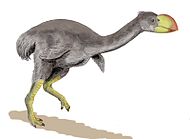
- Family Dromornithidae: this group of birds was more closely related to modern fowl than to modern ratites.
- Dromornis stirtoni, (Stirton's thunder bird) was a flightless bird 3 m (10 ft) tall that weighed about 500 kg (1,100 lb). It is one of the largest birds so far discovered. It inhabited subtropical open woodlands and was probably herbivorous with some omnivory. It was heavier than the moa and taller than the elephant birds.
- Dromornis (formerly Bullockornis) planei (the "demon duck of doom") was another huge member of the Dromornithidae. It was up to 2.5 m (8 ft) tall and weighed up to 250 kg (550 lb); it was probably herbivorous with some omnivory.[31]
- mihirung) was related to Dromornis, and was about the height of an ostrich. It was the last survivor of the Dromornithidae. It had a large lower jaw and was probably herbivorous with some omnivory.
- Progura gallinacea (the giant malleefowl) was a larger relative of the extant malleefowl (Leipoa ocellata).
- Cryptogyps lacertosus
- Dynatoaetus gaffae, largest bird of prey of Australia, second only to the Haast's eagle of New Zealand
Reptiles

- Varanus priscus (formerly Megalania prisca) (the megalania) was a giant carnivorous goanna that might have grown to as long as 7 m (23 ft), and weighed up to 1,940 kg (4,280 lb) (Molnar, 2004). Giant goannas and humans overlapped in time in Pleistocene Australia, but there is no evidence that they directly encountered each other.[32]
- Wonambi naracoortensis was a non-venomous snakeof 5–6 m (16–20 ft) in length. It was an ambush predator living at waterholes located in natural sun traps and killed its prey by constriction.
- mekosuchine subfamily (all now extinct). It was discovered at the Bluff Downs in Queensland.
- olive python (Liasis olivacea).[33]
- Meiolania was a genus of huge terrestrial cryptodire turtles measuring 2.5 m (8 ft) in length, with horned heads and spiked tails.
Extinct megafauna contemporaneous with Aboriginal Australians

Monsters and large animals in Dreamtime stories have been associated with extinct megafauna.
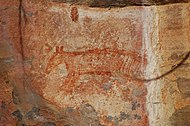
The association was made at least as early as 1845, with colonists writing that Aboriginal people identified Diprotodon bones as belonging to bunyips, and Thomas Worsnop concluding that the fear of bunyip attacks at watering holes remembered a time when Diprotodon lived in marshes.[34]
In the early 1900s, John Walter Gregory outlined the Kadimakara (or Kuddimurka or Kadimerkera) story of the Diyari (similar stories being told by nearby peoples), which describes the deserts of Central Australia as having once been "fertile, well-watered plains" with giant gum trees, and almost solid cloud cover overhead. The trees created a roof of vegetation in which lived the strange monsters called Kadimakara—which sometimes came to the ground to eat. One time, the gum trees were destroyed, forcing the Kadimakara to remain on the ground, particularly Lake Eyre and Kalamurina, until they died.[35]
In times of drought and flood, the Diyari performed corroborees (including dances and blood sacrifices) at the bones of the Kadimakara to appease them and request that they intercede with the spirits of rain and clouds. Sites of Kadimakara bones identified by Aboriginal people corresponded with megafauna fossil sites, and an Aboriginal guide identified a Diprotodon jaw as belonging to the Kadimakara.[35]
Gregory speculated that the story could be a remnant from when the Diyari lived elsewhere, or when the geographical conditions of Central Australia were different. The latter possibility would indicate Aboriginal coexistence with megafauna, with Gregory saying:[35]
If, therefore, the geologist can determine whether the bones of the extinct monsters of Lake Eyre correspond to those described in the aboriginal traditions, he can throw light on several interesting problems. If the legends attribute to the extinct animals characters which they possessed, but which the natives could not have inferred from the bones, then the legends are of local origin. They would prove that man inhabited Central Australia, at the same time as the mighty diprotodon and the extinct, giant kangaroos. If, on the other hand, there is no such correspondence between the legends and the fossils, then we must regard the traditions as due to the habit of migratory peoples, of localising in new homes the incidents recorded in their folklore.
— John Walter Gregory, Dead Heart of Australia
After examining fossils, Gregory concluded that the story was a combination of the two factors, but that the environment of Lake Eyre had probably not changed much since Aboriginal habitation. He concluded that while some references to Kadimakara were probably memories of the crocodiles once found in Lake Eyre, others that describe a "big, heavy land animal, with a single horn on its forehead" were probably references to Diprotodon.[35]
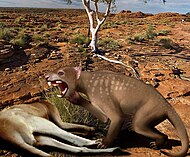
Geologist
Journalist Peter Hancock speculates in The Crocodile That Wasn't that a Dreamtime story from the Perth area could be a memory of
Rock art in the
An Early Triassic archosauromorph found in Queensland, Kadimakara australiensis, is named after the Kadimakara.[43]
See also
- List of Australian animals extinct in the Holocene
- Cuddie Springs – Archaeological site in Australia
- Hulitherium and Maokopia (Diprotodontoids inhabited New Guinea during the Pleistocene)
- Quaternary extinction event– Extinctions of most large mammals during the Late Pleistocene
References
- ^ S2CID 45643228. Retrieved 26 August 2011.
- ^ a b Mackness, B.S. (2009). "Reconstructing Palorchestes (Marsupialia: Palorchestidae) – from Giant Kangaroo to Marsupial 'Tapir'". Proceedings of the Linnean Society of New South Wales. 130: 21–36.
- ^ S2CID 22761857.
- ^ PMID 23650401.
- ^ S2CID 4429899.
- PMID 26821754.
- ^ S2CID 36583693.
- PMID 18719103.
- ^ Roberts, R.; Jacobs, Z. (October 2008). "The Lost Giants of Tasmania" (PDF). Australasian Science. 29 (#9): 14–17. Archived from the original (PDF) on 27 September 2011. Retrieved 26 August 2011.
- ^ Biello, D. (22 March 2012). "Big Kill, Not Big Chill, Finished Off Giant Kangaroos". Scientific American. Retrieved 25 March 2012.
- S2CID 36914192.
- S2CID 26675232.
- S2CID 133737405.
- PMID 32418985.
- PMID 26823193.
- hdl:2328/35952.
- ^ "Humans, not climate change, wiped out Australian megafauna". phys.org. Retrieved 30 May 2017.
- ^ "Aboriginal archaeological discovery in Kakadu rewrites the history of Australia". Smh.com.au. 20 July 2017. Retrieved 5 June 2018.
- ^ Olley, Jon (11 January 2017). "Aboriginal Australians co-existed with the megafauna for at least 17,000 years". theconversation.com. Retrieved 30 May 2017.
- PMID 23650401.
- ^ "The Future Eaters – It's critics". www.abc.net.au. Retrieved 30 May 2017.
- ^ "The Flannery eaters". www.smh.com.au. 5 June 2004. Retrieved 30 May 2017.
- .
- PMID 33783356.
- ISBN 978-0-9803813-2-0
- ISBN 1-876622-50-4
- ISBN 1-876622-50-4
- PMID 28954903.
- ^ Salleh, Anna (25 June 2020). "Fossil of modern wombats' giant extinct cousin found in US museum, 50 years after initial discovery". ABC News. Australian Broadcasting Corporation. Retrieved 30 June 2020.
- doi:10.1071/ZO05077.
- ^ Australian Museum
- .
- S2CID 85185368.
- ISBN 978-0642107329.
- ^ a b c d Gregory, J. W. (John Walter) (1906). The dead heart of Australia. University of California Libraries. London : J. Murray. pp. 3–7, 74, 224, 230–235.
- ^ Welland, Michael (September 2017). "So the land is actually like a big book, you know?" (PDF). Global Land Outlook: 9–10.
- ^ "WA history author goes digital". PerthNow. 11 September 2012. Retrieved 12 May 2018.
- ISBN 978-1486300303.
- ^ Akerman, Kim. "An ancient rock painting of a marsupial lion, Thylacoleo carnifex, from the Kimberley, Western Australia".
- ^ "More Megafaunal Depictions in Bradshaw Rock Art" (PDF).
- ISSN 0728-4896.
- ^ "Megafauna cave painting could be 40,000 years old". ABC News. 31 May 2010. Retrieved 12 May 2018.
- PMID 27162705.
- PMID 19789642.
- ^ "Australia was 'hothouse' for killer lizards". Australian Broadcasting Corporation. 30 September 2009. Retrieved 30 September 2009.
- Field, J. H.; Dodson, J. (1999). "Late Pleistocene megafauna and archaeology from Cuddie Springs, south-eastern Australia". Proceedings of the Prehistoric Society. 65: 1–27. S2CID 131617908.
- Field, J. H.; Boles, W. E. (1998). "Genyornis newtoni and Dromaius novaehollandiae at 30,000 b.p. in central northern New South Wales". Alcheringa. 22 (#2): 177–188. .
- Long, J.A., Archer, M. Flannery, T.F. & Hand, S. (2003). Prehistoric Mammals of Australia and New Guinea −100 Million Years of Evolution. Johns Hopkins University Press, Baltimore. 242 pp.
- Molnar, R. (2004). Dragons in the Dust: The Paleobiology of the Giant Lizard Megalania. Indiana University Press. p. 127.
- Murray, P. F.; Megirian, D. (1998). "The skull of dromornithid birds: anatomical evidence for their relationship to Anseriformes (Dromornithidae, Anseriformes)". Records of the South Australian Museum. 31: 51–97.
- Wroe, S.; Field, J.; Fullagar, R. (2002). "Lost giants". Nature Australia. 27 (#5): 54–61.
- Prideaux, Gavin J; Roberts, Richard G.; Megirian, Dirk; Westaway, Kira E.; Hellstrom, John C.; Olley, John M. (2007). "Mammalian responses to Pleistocene climate change in southeastern Australia" (PDF). Geology. 35 (#1): 33–36. .


